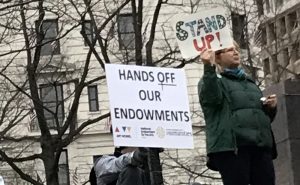On March 16th President Trump announced that he wants to eliminate the National Endowment for the Arts (NEA) along with the National Endowment for the Humanities (NEH) and the Corporation for Public Broadcasting (CPB) from the Fiscal Year 2018 budget. The NEA was established by Congress in 1965 as an independent federal agency that aims to strengthen the creative capacity of Americans, by providing them the opportunity to participate in the most diverse forms of arts and culture. But they not only fund and support art learning, the NEA also wants to deepen America’s cultural heritage and provide a more equal access to the arts across the country, making sure that all Americans have access to art no matter where they are from.
Congress will decide whether the NEA will be defunded next year or not. If they vote to eliminate the NEA from the FY 2018 budget they would not only be hurting the economy, since the arts and culture sector accounts for $742 billion or 4.2 percent of the country’s GDP and creates many jobs (4.7 millions works in the industry), but they would be also eliminating investment in America’s creativity. The NEA arts education grant program, focused on pre-k to 12th grade students, helps students develop creativity, a really valued skill for employers nowadays. It also helps them become better readers and writers through drama. For example, a student can increase reading readiness in early grades and improve reading comprehension and writing skills in middle and high school. Moreover, defunding the NEA would hurt the underrepresented and low-income communities the most since a significant percent of their grants benefits those who cannot afford the arts; 40% of NEA-supported activities take place in high-poverty neighborhoods and 36% of NEA grants go to organizations that reach underserved populations such as people with disabilities, people in institutions, and veterans. In their mission of providing equal access to arts across the country, the NEA makes sure to distribute in an equitable way their funds, reaching rural areas, inner-city and underserved communities.
Also, public funding encourages private giving. When the NEA gives money to a nonprofit organization, it gives them credibility and helps them attract more funders. In addition, the NEA’S funding has to be matched with other sources of funding so it’s an investment that can spur public-private partnerships.
In my opinion, the White House’s decision of cutting the funding for the NEA seems unreasonable. The NEA budget corresponded to only 0.004% of the 3.65 trillion federal budget in 2017 and with only 150 million a year ($0.46 per American), the NEA is able to support and boost arts and culture in the country, that translates into more jobs, creativity, better education, public-private partnerships and a social, economic and cultural positive impact in American citizens.
In what other ways does defunding NEA affect US education? This is not the first time that Republicans threaten to eliminate the NEA or other arts, humanities and cultural federal programs, do you think this time they will succeed?
Sources:
https://www.arts.gov/about-nea
https://www.arts.gov/sites/default/files/nea-quick-facts.pdf
https://www.arts.gov/sites/default/files/NEA-FAQ-march2017.pdf
https://www.arts.gov/sites/default/files/Arts_Education_fact_sheet_nov2016.pdf
http://time.com/money/4639544/trump-nea-sesame-street-budget-cut/
https://www.nytimes.com/2017/03/17/arts/nea-neh-trump-congress.html?_r=0

